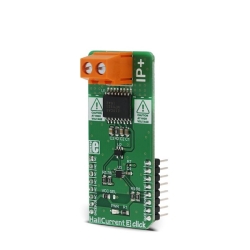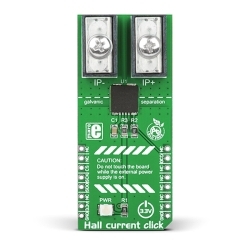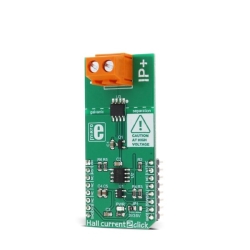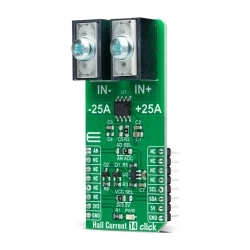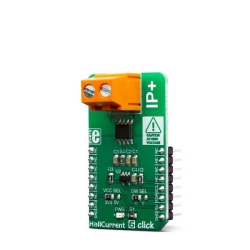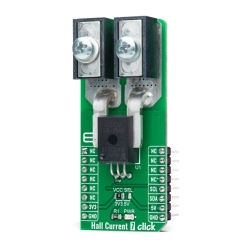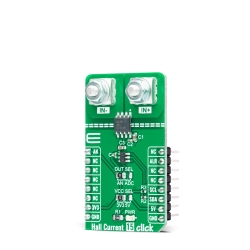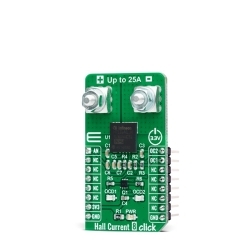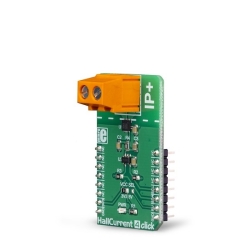MIKROE Hall Current 13 Click
Hall Current 13 Click is a compact add-on board that provides economical and precise AC or DC current sensing solutions.
Product Overview
Hall Current 13 Click is a compact add-on board that provides economical and precise AC or DC current sensing solutions. This board features the TMCS1107-Q1, a galvanically isolated Hall-effect current sensor capable of DC or AC current measurement with high accuracy, excellent linearity, and temperature stability from Texas Instruments. It enables the lowest drift, <3% full-scale error, and highest accuracy over time and temperature. It also provides a reliable 420V lifetime working voltage and 3kVRMS isolation between the current path and circuitry with uni/bidirectional current sensing. Besides, the user is allowed to process the output signal in analog or digital form. This Click board™ is suitable for AC or DC current-sensing in industrial and commercial systems, motor and load control, power factor correction, overcurrent protection, and many more.
Hall Current 13 Click is supported by a mikroSDK compliant library, which includes functions that simplify software development.
Hall Current 13 Click as its foundation uses the TMCS1107-Q1, a precise Hall-effect current sensor, featuring a 420V isolation working voltage, <3% full-scale error across temperature, and device options providing both unidirectional and bidirectional current sensing from Texas Instruments. The input current flows through an internal 1.8mΩ conductor that generates a magnetic field measured by an integrated Hall-effect sensor and amplified by a precision signal chain. The device has a bandwidth of 80kHz and can be used for AC and DC current measurements. It is optimized for high accuracy and temperature stability, with offset and sensitivity compensated across the operating temperature range.
This Click board™ possesses two ways to communicate with the MCU. The analog output signal of the TMCS1107-Q1 can be converted to a digital value using MCP3221, a successive approximation A/D converter with a 12-bit resolution from Microchip using a 2-wire I2C compatible interface, or can be sent directly to an analog pin of the mikroBUS™ socket labeled as AN. Selection can be performed by onboard SMD switch labeled as VOUT SEL, setting it to an appropriate position marked as AN and ADC.
The MCP3221 provides one single-ended input with low power consumption, a low maximum conversion current, and a Standby current of 250μA and 1μA, respectively. Data can be transferred at rates of up to 100kbit/s in the Standard and 400kbit/s in the Fast Mode. Also, maximum sample rates of 22.3kSPS with the MCP3221 are possible in a Continuous-Conversion Mode with a clock rate of 400kHz.
Also, this Click board™ should be connected in series with the load. The current is measured by two onboard terminal connectors, one terminal block for the positive and the other for the negative current input.
This Click board™ can operate with both 3.3V and 5V logic voltage levels selected via the VCC SEL jumper. This way, it is allowed for both 3.3V and 5V capable MCUs to use the communication lines properly. However, the Click board™ comes equipped with a library containing easy-to-use functions and an example code that can be used, as a reference, for further development.
Features & Specs
- Interface: Analog, I2C
- Compatibility: mikroBUS™
- Dimensions: 57.15 x 25.4mm
- Input Voltage: 3.3V or 5V
- Supply Voltage: Min. 3.8V, Max. 5V
- Measurement Range @ VCC=3.3V: Min. -2.8A, Max. 27.7A
- Measurement Range @ VCC=5V: Min. -4.5A, Max. 43A
- Sensitivity: 100 mV/A
- Operating Temperature Range: Min. -40°C, Typ. +25°C, Max. +120°C
Documentation
Customer Reviews
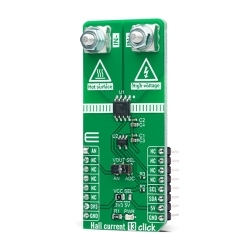
Stock and Customer Discounts
Available Discounts
- $37.00 | 25+ units
- $35.06 | 100+ units


